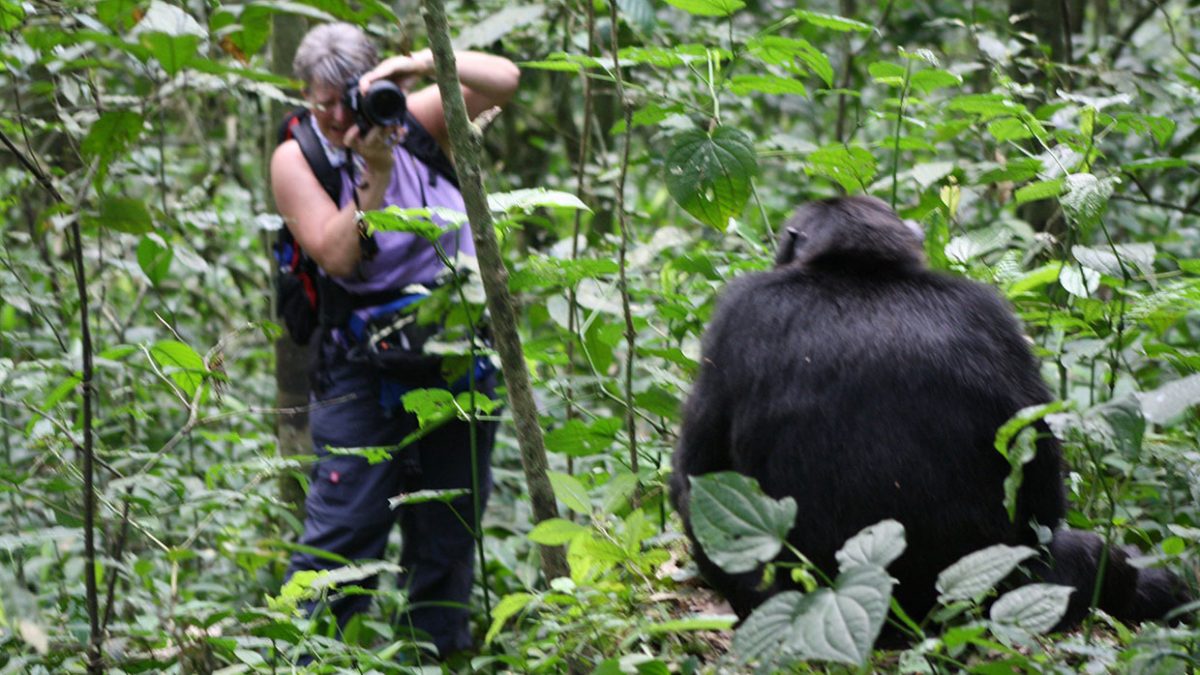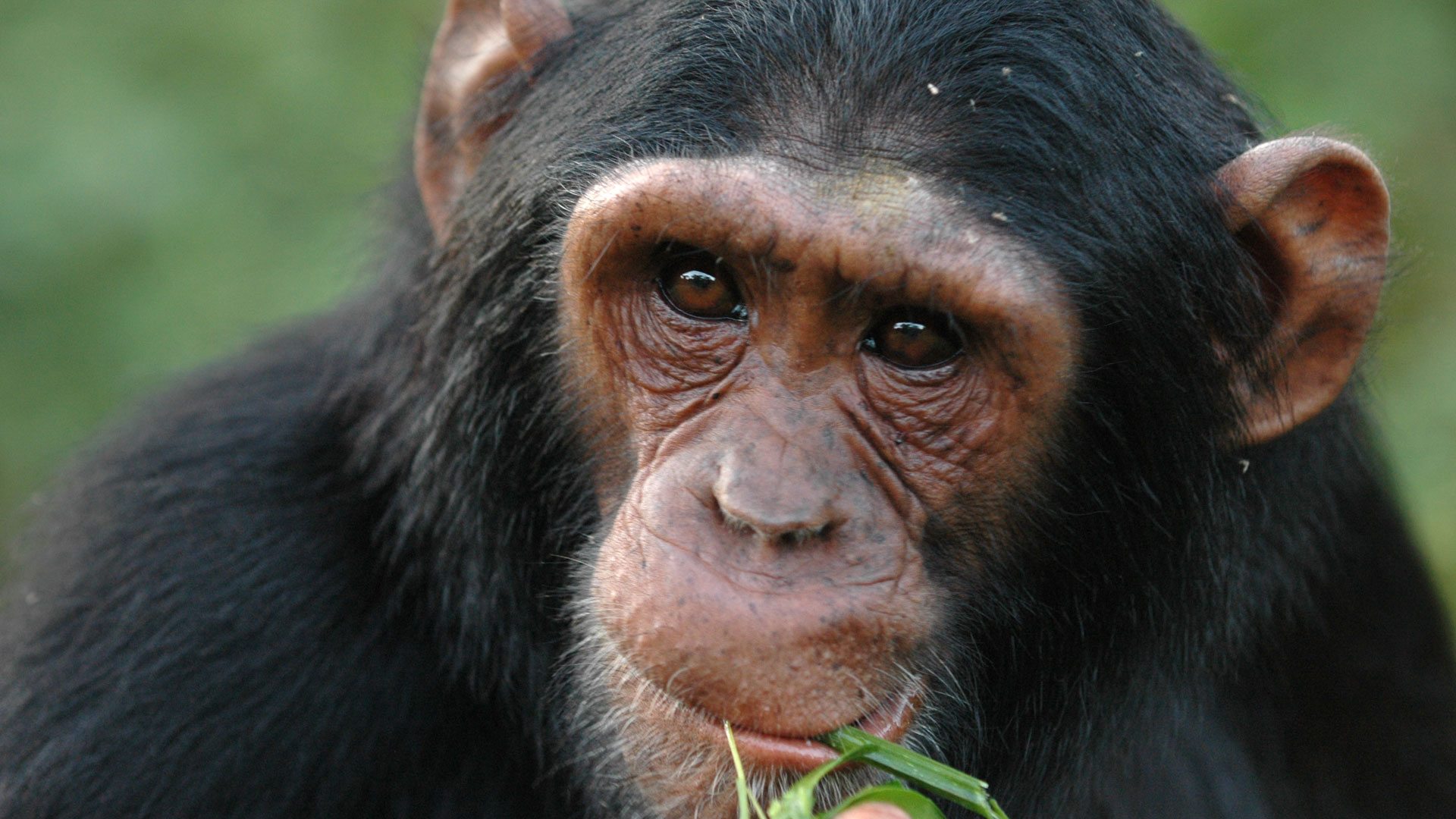Chimpanzee Tracking in Tanzania
Chimpanzee trekking in Tanzania is an experience away from the usual wildlife safaris in the Serengeti, Ngorongoro, Tarangire and Lake Manyara national park which make the northern circuit of the numerous in Tanzania.
Most safari enthusiasts associate Tanzania rolling savannas, herds of wildebeest mowing extensive grasslands and a plethora of iconic predators. It does not, however, immediately conjure images of chimpanzees swinging through forest canopies. Yet, there are two national parks where visitors can combine the Tanzania safari experience with chimpanzee trekking: Gombe Stream National Park and Mahale Mountains National Park. For those in the know, these two remote sections of one of the wildest parts of Africa are something of a primate mecca – where a pilgrimage to meet our forest closest relatives takes place in the verdant forests along the shore of one of the continent’s Great Lakes.

For those in search of a specialist adventure on the outer wilderness fringes of Tanzania, there is little to compare to the excitement and beauty of this remote, uninhabited park. Mahale is a long way off the beaten path, so it is something an investment, but the area’s sugar white beaches, the extraordinary forest and the chimpanzees are well worth the time, effort and expense. This is adventure at its most original.
There is, in our opinion, only one camp from which to fully appreciate the magic of Lake Tanganyika and the chimpanzee treks:
GOMBE STREAM NATIONAL PARK
In contrast to the massive Mahale Mountains National Park, Gombe is one of Tanzania’s smallest national parks, a fragile and precious patch of chimpanzee habitat of just 56km² (5,600 hectares), 16km north of the city of Kigoma. Despite its small area, this intimate park sports excellent biodiversity and, in the world of primate research, is celebrated as the home of chimpanzee study. It was here that Jane Goodall first set up her now-famous research Centre during the 1960s. Arriving without any “formal” training, Dame Goodall was free from the scientific dogma of the times, which allowed for very little insight into the workings of the minds of wild animals.
MAHALE MOUNTAINS NATIONAL PARK
The enormous Mahale Mountains National Park extends over 1,650km² (165,000 hectares) of craggy mountains and rolling hills. It encompasses (and is named for) the forested Mahale Mountains, where the highest points of Mount Nkungwe reach elevations of over 2,400 metres. The verdant forests along the western slopes are home to a substantial population of chimpanzees (over 1,000 individuals). The chimps of Mahale are part of an ongoing, 50-year-old study. The other side of the mountain range opens up into savannas – home to lions, elephants, zebras, giraffes, and roan and sable antelope. Keen birders can also keep their eyes peeled for the park’s many bird species (over 230 species recorded so far, but the number is likely substantially higher), with specials like the palm-nut vulture and Livingstone’s turaco.
Of course, the vast area and dramatic scenery can make for a challenging search for chimpanzees, should they decide to move away from the more accessible beach areas. Crawling through dense vegetation on hands and knees is not out of the question, but the more intense the search, the more rewarding a chimpanzee sighting will be. While searching for chimps, visitors will find themselves enthralled by some of the other forest creatures, including yellow baboons, vervet, red-tailed, and colobus monkeys (both the red and Angolan black-and-white colobus species). Really fortunate visitors may even witness (or hear) the chimpanzees hunting their smaller cousins, particularly the red colobus monkeys. This is a once-in-a-lifetime experience, though potentially a curiously chilling one.
Despite being about 1,000km away from the nearest ocean, there is a definite tropical, paradise island feels about the shores of Lake Tanganyika in Mahale. The turquoise waters stretch as far as the eye can see and warm waves lap gently onto the shores of unspoilt sandy coves. The park’s lodges are situated on the beach, and guests can opt to rinse away the chimp-trek sweat with a dip in the lake (content in the knowledge that crocodiles only rarely visit).
Having named her subjects, Goodall set about observing them in earnest. Here, she first observed chimpanzees using tools to “fish” for termites and learnt to reconcile the more affectionate aspects and behaviors with the darker sides of their lives. These included systematic primate hunting techniques and extraordinary potential for intraspecific violence and conflict. Today, the 60-year study is the longest-running field study of an animal species in its natural surroundings. It has supplied us with a vast amount of what we now know about chimpanzee behavior. The famous chimpanzees have been the subjects of many a thesis, film, and documentary series.
As in Mahale, Gombe is open to day-visitors in possession of a 24-hour pass and guide. However, the park is best experienced over a couple of days spent at one of the lodges. There are many other species to be appreciated, including over 200 birds and a similar variety of primate species to Mahale. One particularly habituated troop of yellow baboons spends its time close to the shoreline and is a constant source of enjoyment and entertainment for guests.
Away from the tourist centres and the northern/southern safari circuits, self-travel through western Tanzania is suitable only for the more adventurous, experienced, and patient traveler. It is very rural, with few roads and little in the way of infrastructure.
Travel to Mahale and Gombe can be a little arduous but interesting. Long flights and scenic boat voyages offer scenes of Crusoe-like bandas and thatch on paradise beaches. Ultimately, this remoteness and simplicity is a significant ingredient in the magic of a stay in Tanzania’s chimpanzee forests. The fact that it can be enjoyed in one of the high-end lodges with every need provided for is an added bonus.
Chimpanzee Trekking Experience in Tanzania
Chimpanzee trekking experiences in Tanzania do not need any set of skills. But rather the good physical shape to hike through mountain ranges and forests. It often starts at 08:00 am with a briefing about the experience. Here, guests are taken through chimpanzee trekking. Also, the guidelines for chimpanzee trekking and thereafter the experience begins. In groups of 6, guests are guided through the guided trails in search of the apes. Following clues like their previous night’s nest, fresh chimp dung, and leftover fruit, you finally find them.
Marveling at the chimpanzees swing between tree branches up in the tree canopies is breathtaking. Watch the mother chimps collect insects and termites from trees to feed their babies. Watch them groom each other and play. Most of these individuals are habituated. Hence, human beings have the opportunity to have closer encounters with them.
While trekking chimpanzees, you also encounter birds, olive baboons, monkeys, roan antelopes, and bush pigs in the forest.
Best time for Chimpanzee Trekking in Tanzania
The best time to visit falls between May and October, which corresponds to the dry season in this part of Tanzania. During this time, the terrain in the forests is accessible. the vegetation is short. The trekking trails are also less muddy and slippery. Also, chimps are closer to the lower slopes of the mountains, thus easier to find.

The high rainfall levels from November until April can make the paths extremely slippery and challenging, with the added disadvantage that the chimpanzees prefer to spend less time on the ground and more in the canopy.
Rules and Regulations for Chimpanzee Trekking in Tanzania
For one to trek chimpanzees, one must be 15 and above years of age.
Tourists are prohibited from smoking, eating, or drinking near chimpanzees.
Flash photography is prohibited. Tourists are required to always turn off their camera flashes when taking photos of the chimps.
Do not litter while in the forest. Keep your rubbish and dump it in the dustbins at the park headquarters.
One is not allowed to trek chimpanzees when one is ill. Chimpanzees are susceptible to human diseases.
Tourists are also required to follow the instructions given at the time of briefing. And from the guides during trekking.
While with the chimpanzees, ensure to maintain a distance of at least 8 meters. This is to prevent the chimps from feeling overcrowded and surrounded.
Always maintain a low tone of voice while in the presence of chimpanzees. Noise can alert the primates.
What you need for Chimpanzee Trekking in Tanzania?
- A chimpanzee trekking permit. This is a card that permits you to trek chimpanzees in their natural habitat
- Good hiking shoes for comfortable navigation through the steep slopes and rough terrain
- Long-sleeved shirts and long trousers. These will protect you from the sharp tree branches and thorns
- Plenty of drinking water and a packed lunch or snacks to keep you energized.
- A rain poncho for the unpredictable rains in the tropical rainforests.
- A pair of binoculars to help you capture far-reaching sights of the chimpanzees on tree tops.
- A good camera and batteries if you want to capture the perfect shots of the primates and nature at large.
- A backpack. You will need a backpack to carry and protect all your items.
For those in search of a specialist adventure on the outer wilderness fringes of Tanzania, there is little to compare to the excitement and beauty of this remote, uncluttered park. Mahale is a long way off the beaten path, so it is something an investment, but the area’s sugar white beaches, the extraordinary forest and the chimpanzees are well worth the time, effort and expense. This is adventure at its most original.

